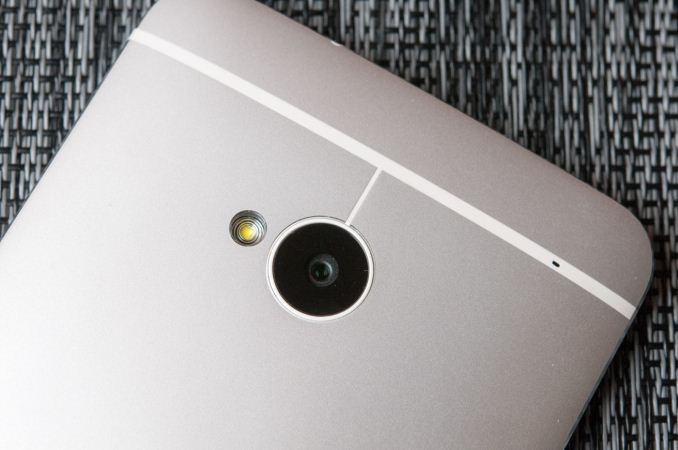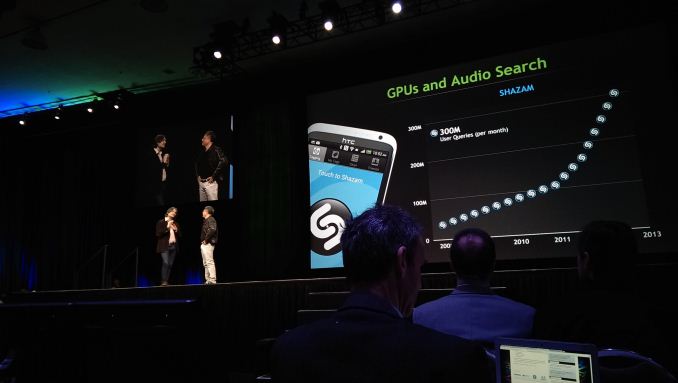The HTC One: A Remarkable Device, Anand’s mini Review
by Anand Lal Shimpi on March 21, 2013 4:49 PM EST- Posted in
- Smartphones
- HTC
- Mobile
- HTC One
The Camera
If the One’s industrial design and materials choices make it nice to own, it’s the camera that makes the One a must have. In fact, that’s how it all started for me. I popped my test sim into the One and started carrying it around with my iPhone 5 as I went about the user experience part of my review process. I quickly found myself only taking photos using the One, and using the 5 for everything else. After a few days, the 5 was pretty much only used to check iMessages and answer calls to that number - with the One being used for everything else.
I remember talking to Brian after he first learned about what HTC decided to do with the One’s camera system. I believe he said something like “this is exactly what they should be building”. In the three years I’ve worked with Brian I don’t think I’ve ever heard him say that about any smartphone OEM’s decision with any component/subsystem. The strong endorsement was enough to pique my interest in the One.
Brian will go into great detail about the One’s camera in his review, and what I’ll provide here is no where near doing it justice but I’ll do my best.
At a high level, HTC’s strategy with the One is to boldly bow out of the megapixel race and instead integrate a lower resolution rear facing camera sensor with larger pixels. Each pixel in the One’s 4MP rear facing camera sensor is over 2x larger than those in the iPhone 5, and even larger than those in the Galaxy S 4. Larger pixels help ensure a better signal to noise ratio, which in turn can really improve low light performance when paired with a suitable lens.
The downsides are obvious. Very well lit scenarios can suffer compared to a higher resolution sensor, and the bigger issue for HTC is that 4MP doesn’t sound as good to the uninformed consumer compared to the Galaxy S 4’s 13MP rear camera. HTC tried to get around the latter problem by calling its larger pixels Ultrapixels, but then it’s up to point of sale training to ensure that the benefits are adequately conveyed. Call me cynical but I don’t have a bunch of faith there.
The F2.0 lens ensures a bunch of light can hit the sensor, and the result is easily the best low light performance I’ve ever seen in any Android or iOS smartphone. I took this shot during Jen-Hsun’s GTC 2013 keynote earlier this week:
The One seems to want to drive ISO as high as possible to increase brightness, so for this particular shot I manually set ISO down to 100, but otherwise everything else was left to defaults.
The Auto ISO algorithm doesn’t always drive itself super high however, the shot below is outside of Terminal 2 at the RDU airport at 11:29PM:
For this shot I didn’t touch anything and the result was a surprisingly low-noise shot.
It’s not just night shots where the One’s camera excels, but also in the more common poorly lit indoor scenarios where I come away very impressed:
HTC One
In well lit outdoor scenes the One’s camera does a reasonable job (although HTC seems to have an issue with noise in these well lit scenes from whatever processing they seem to be doing):
Integrating a good sensor and camera system is just part of what the One does really well here. The feature that I’ve found resonates the best among normal smartphone users is the highlights reel.
Sense 5.0 will automatically assemble 30 second highlights videos based on photos and video you’ve taken throughout your day. The One automatically adds filters, background music and stitches everything together; all you have to do is use the camera to take photos and video, everything else happens automatically.
The highlights reel below is one that was automatically generated based on my photos and videos from opening day at GTC 2013:
Although highlights reels are automatically generated, you can also generate highlights of individual albums. I created an album of photos I had taken over the past couple of trips (as well as some shots I took at home) and the One created this video:
Each highlights reel is shared as standard MP4 (baseline profile, ~3Mbps 720p H.264), so compatibility isn't a concern.
You can manually choose from multiple themes (filters/music combinations, 6 total), but there’s unfortunately no way to add your own background music yet (I suspect this is coming in the next major update).
The highlights reel is easily the most emotionally engaging feature the One has to offer, even ranking above aesthetics and build quality in my opinion. It’s the type of feature that really seems to resonate with everyone I show it to. The killer aspect in all of this is the fact that the One will put together highlights reels automatically, with no user intervention.
I can see the background music and filters getting boring after a while, and that’s why it’s very important for HTC to quickly enable end users to supply their own audio tracks (as well as quickly - and regularly - expand the collection of filters offered).
The downside to the One’s highlights reel autonomy is the feature remains relatively buried, almost hidden in the gallery app rather than front and center like Blinkfeed. The highlights reel is easy to demonstrate to someone else, it’s just not as obvious of a feature when you pick up the phone for the first time.
I haven’t touched on Zoe, the ability to simultaneously shoot stills and record a short video - both at full res. Zoe is a difficult feature to really explain without demonstrating it, but it does wonders in the creation of highlights reels. Zoe is a great way of dealing with the problem of what to do when your subject is in motion - do you hope for a good still or just capture a video? Zoe interestingly enough does both. It’ll capture a 1080p30 video, as well as 20 full resolution (4MP) stills at the same time.
I’ve mostly been using Zoe as a way to make my highlights reels more interesting, but the best use case I’ve seen was actually by a friend of mine who used it to capture the actions of some street performers in Europe. In one Zoe he had performers spinning on their heads, which typically would make for a good video or an emotionless (but potentially cool) still. Zoe delivered both.
The One, like Nokia’s Lumia 920, features optical image stabilization (OIS), which is designed to help both in shooting video as well as improving low light performance. In practice, I’m not super impressed with the OIS implementation on the One. It seems to need a bit of tuning, but I’ll leave it to Brian to explain exactly what’s going on.
Shot to shot latency on the One is amazing. Video quality is solid as well.
The One has the physical beauty to get you interested, but the camera prowess to keep you engaged.
















434 Comments
View All Comments
CeriseCogburn - Monday, March 25, 2013 - link
Class 4 is fast enough actually. Just jayspew doesn't really know anything.eebrah - Saturday, March 23, 2013 - link
Why trust that " $COMPANY are not Apple, they probably won't do $BAD_THING " when you can guarantee that they won't fuck you over by getting some features out of the box? say expandable storage and removable battery?phillyry - Sunday, March 24, 2013 - link
Pylon757+1
jayseeks - Friday, March 22, 2013 - link
I've never met anyone who actually purchased one of those battery packs on their own. 9 out of 10 people with those battery packs likely purchased it on a company account.CeriseCogburn - Monday, March 25, 2013 - link
You don't know anyone basement dweller, or anything. Pure trollboy.SirSuperman - Thursday, March 21, 2013 - link
A USB battery pack, which usually requires you to carry a cable around and attach it to your phone and then use your phone with something hanging off it while charging is easier than simply slipping in a battery and instantly returning to a full charge?Pylon757 - Thursday, March 21, 2013 - link
You forgot the part about having to turn the phone off and on.acky2lum - Friday, March 22, 2013 - link
I still don't get why ppl can't get off the grid for that 30 seconds or less. Are you saying your usb battery pack can instantly charge your battery to a full charge within that 30 seconds?Johnmcl7 - Thursday, March 21, 2013 - link
"When I had phones with removable batteries, the only time I ever removed them was to do a hard reset of the phone. Most people don't want to carry around extra batteries, and even if they do, a USB battery pack is easier to carry around than a bare battery."I find USB battery packs a fiddle to use as they're usually a lot larger than a bare battery and they need to remain connected to the phone for quite some time. I take a spare battery when I'm away travelling as it takes a matter of seconds to swap the battery over when the original one dies and then I have a fully functional phone again without having to leave it connected to anything.
Also the other reason I prefer a removable battery is that li-ion batteries don't last forever, they're unlikely to last the two years I expect a phone to last without losing performance if not outright failing and given the reasonably poor batterylife of these devices in the first place that's a prominent issue. Neither my N900 or Galaxy Note's original batteries lasted two years but it wasn't an issue as a couple of minutes later they were up and running with another battery.
"Most people also don't carry around spare memory cards, either. I can understand why someone might be worried about not being able to add additional storage space to a phone that only comes with 8 or even 16GB of storage, but do you really expect the average user to run out of space in a phone that comes with up to 64GB of flash? My desktop PC has only a 64GB SSD right now! Especially in the age of streaming media, memory cards are increasingly unnecessary in smartphones."
With increasingly powerful phones, higher resolution onboard video and increasingly higher resolutions, I disagree - why put up with lower quality video and reduced selection rather than have the option of being able to cheaply add storage. The Note's large vibrant screen is great for watching and showing videos, yes I could delete off the 1080p video files from its own camera and have a much smaller selection of videos but for the small cost of a microSD card I prefer to keep them onboard and take advantage of the screen Plus the price companies charge for storage is usually vastly more than it would cost as a microSD card, the cost difference between a Nexus 8GB and a 16GB over here would be enough to purchase a 64GB micro SD card. It also means the phone can take advantage of increasing flash capacities over its life.
As for streaming as a viable alternative, I also disagree for quite a few reasons. Firstly it may not even be possible either due to reception not being good enough, not allowed to have wireless radios enabled or congestion in the area, secondly data caps are frequently restrictive and third the phone needs a lot more power to stream wirelessly compared to just reading it off internal memory.
Plus there no gains from not having a removable battery or expandable storage with the HTC (aside from for HTC themselves), despite the praise in this article I don't count the metal body as a plus because if it's anything like previous HTC phones and most other metal phones on the market the metal is unlikely to be particularly durable and will easily pick up scratches and chips. There's a lot of complaining about Samsung using plastics but they're light and they're durable, I've seen some original S2's that have been used without a case and dropped a few times yet they've barely a mark on them whereas Sensations from the same time period were looking fairly battered in the same conditions after a few weeks despite the praise for the Sensation's supposed industrial build quality and the cheap build quality of the S2.
John
CeriseCogburn - Friday, March 22, 2013 - link
The apple tards suddenly have no media - no music, no movies, no videos, no minutes and minutes of high resolution camera movies - the appletards don't like storage space, they yell at Siri to dial then they pocket their lead weight glass shatterbrick.I guess it was all true - apple users are inherently STUPID...